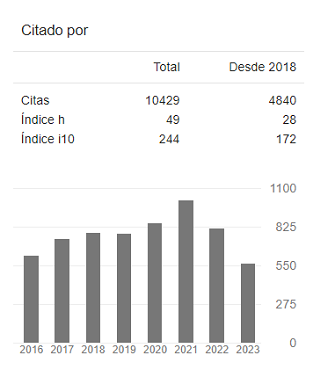Resumen (es):
En diciembre de 2021 se desarrolló la primera expedición a los montes submarinos de las dorsales de Malpelo y de Yuruparí. En total se exploraron ocho montes submarinos por medio de BRUVS (Baited Remote Underwater Video Systems). Se desplegaron 48 BRUVS, registrando cinco especies pelágicas (Sphyrna lewini, Mobula birostris, Pteroplatytrygon violacea, Kajikia audax y Istiophorus platypterus), donde Pteroplatytrygon violacea constituyó un nuevo registro para la región. En todas las zonas se registraron especies pelágicas, aunque los tiburones se asociaron exclusivamente a los montes al oeste de las dorsales, en especial al monte conocido como Bajo Navegador, el más somero de la región. Este trabajo es un primer paso para orientar las siguientes exploraciones de estos ecosistemas.
Resumen (en):
In December 2021, we conducted the first expedition to the seamounts of the Malpelo and Yuruparí ridges. Eight seamounts were explored using Baited Remote Underwater Video Systems (BRUVS). A total of 48 BRUVS were deployed, registering five pelagic species (Sphyrna lewini, Mobula birostris, Pteroplatytrygon violacea, Kajikia audax and Istiophorus platypterus) where Pteroplatytrygon violacea constituted a new record for the region. Pelagic species were recorded in all seamounts, although sharks were exclusively associated with the seamounts to the west of the ridges, especially in the area known as Bajo Navegador, the shallowest seamount in the region. This work is a first step to guide the following explorations of these ecosystems.
Palabras clave:
BRUVS, Dorsal of Malpelo, Dorsal of Yuruparí, Fauna monitoring, Pelagic fauna, Sharks (en)
Referencias
Bessudo, S., Soler, G. A., Klimley, A. P., Ketchum, J. T., Hearn, A., & Arauz, R. (2011). Residency of the scalloped hammerhead shark (Sphyrna lewini) at Malpelo Island and evidence of migration to other islands in the Eastern Tropical Pacific. Environmental Biology of Fishes, 91(2), 165–176. https://doi.org/10.1007/s10641-011-9769-3
Bessudo, S., Soler, G., Klimley, P., Ketchum, J., & Arauz, R. (2011). Vertical and Horizontal Movements of the Scalloped Hammerhead Shark ( Sphyrna Lewini ) Around Malpelo and Cocos Islands ( Tropical Eastern Pacific ) Using Satellite Telemetry. Boletín de Investigaciones Marino Costeras, 40, 91–106.
Bouchet, P. J., & Meeuwig, J. J. (2015). Drifting baited stereo-videography: A novel sampling tool for surveying pelagic wildlife in offshore marine reserves. Ecosphere, 6(8). https://doi.org/10.1890/ES14-00380.1
Caldwell, Z. R., Zgliczynski, B. J., Williams, G. J., & Sandin, S. A. (2016). Reef fish survey techniques: Assessing the potential for standardizing methodologies. PLoS ONE, 11(4). https://doi.org/10.1371/journal.pone.0153066
Cambra, M., Lara-Lizardi, F., Peñaherrera-Palma, C., Hearn, A., Ketchum, J. T., Zarate, P., Chacón, C., Suárez-Moncada, J., Herrera, E., & Espinoza, M. (2021). A first assessment of the distribution and abundance of large pelagic species at Cocos Ridge seamounts (Eastern Tropical Pacific) using drifting pelagic baited remote cameras. PLoS ONE, 16(11 November), 1–25. https://doi.org/10.1371/journal.pone.0244343
Cappo, M., Harvey B, E., Malcolm, H., & Speare, P. (2003). Potential of video techniques to monitor diversity, abundance and size of fish in studies of marine protected areas. GEOMDOFT. www.geomsoft.com.au
Cappo, M., Speare, P., & De’Ath, G. (2004). Comparison of baited remote underwater video stations (BRUVS) and prawn (shrimp) trawls for assessments of fish biodiversity in inter-reefal areas of the Great Barrier Reef Marine Park. Journal of Experimental Marine Biology and Ecology, 302(2), 123–152. https://doi.org/10.1016/j.jembe.2003.10.006
Chávez, E. J., Arauz, R., Hearn, A., Nalesso, E., & Steiner, T. (2020). Asociación de tiburones con el Monte Submarino Las Gemelas y primera evidencia de conectividad con la Isla del Coco, Pacífico de Costa Rica. Biologia Tropical, 68(March).
Colton, M. A., & Swearer, S. E. (2010). A comparison of two survey methods: Differences between underwater visual census and baited remote underwater video. Marine Ecology Progress Series, 400, 19–36. https://doi.org/10.3354/meps08377
Dapp, D., Arauz, R., Spotila, J. R., & O’Connor, M. P. (2013). Impact of Costa Rican longline fishery on its bycatch of sharks, stingrays, bony fish and olive ridley turtles (Lepidochelys olivacea). Journal of Experimental Marine Biology and Ecology, 448, 228–239. https://doi.org/10.1016/j.jembe.2013.07.014
Dulvy, N. K., Fowler, S. L., Musick, J. A., Cavanagh, R. D., Kyne, P. M., Harrison, L. R., Carlson, J. K., Davidson, L. N., Fordham, S. v, Francis, M. P., Pollock, C. M., Simpfendorfer, C. A., Burgess, G. H., Carpenter, K. E., Compagno, L. J., Ebert, D. A., Gibson, C., Heupel, M. R., Livingstone, S. R., … White, W. T. (2014). Extinction risk and conservation of the world’s sharks and rays. ELife, 3, 1–34. https://doi.org/10.7554/elife.00590
Dulvy, N. K., Freckleton, R. P., & Polunin, N. V. C. (2004). Coral reef cascades and the indirect effects of predator removal by exploitation. Ecology Letters, 7(5), 410–416. https://doi.org/10.1111/j.1461-0248.2004.00593.x
Espinoza, M., Araya-Arce, T., Chaves-Zamora, I., Chinchilla, I., & Cambra, M. (2020). Monitoring elasmobranch assemblages in a data-poor country from the Eastern Tropical Pacific using baited remote underwater video stations. Scientific Reports, 10(1), 1–18. https://doi.org/10.1038/s41598-020-74282-8
Espinoza, M., Cappo, M., Heupel, M. R., Tobin, A. J., & Simpfendorfer, C. A. (2014). Quantifying shark distribution patterns and species-habitat associations: Implications of Marine Park zoning. PLoS ONE, 9(9). https://doi.org/10.1371/journal.pone.0106885
Harrison, A. L., Costa, D. P., Winship, A. J., Benson, S. R., Bograd, S. J., Antolos, M., Carlisle, A. B., Dewar, H., Dutton, P. H., Jorgensen, S. J., Kohin, S., Mate, B. R., Robinson, P. W., Schaefer, K. M., Shaffer, S. A., Shillinger, G. L., Simmons, S. E., Weng, K. C., Gjerde, K. M., & Block, B. A. (2018). The political biogeography of migratory marine predators. Nature Ecology and Evolution, 2(10), 1571–1578. https://doi.org/10.1038/s41559-018-0646-8
Heagney, E. C., Lynch, T. P., Babcock, R. C., & Suthers, I. M. (2007). Pelagic fish assemblages assessed using mid-water baited video: Standardising fish counts using bait plume size. Marine Ecology Progress Series, 350, 255–266. https://doi.org/10.3354/meps07193
Hearn, A., Ketchum, J., Klimley, A. P., Espinoza, E., & Peñaherrera, C. (2010). Hotspots within hotspots? Hammerhead shark movements around Wolf Island, Galapagos Marine Reserve. Marine Biology, 157(9), 1899–1915. https://doi.org/10.1007/s00227-010-1460-2
Heupel, M. R., Knip, D. M., Simpfendorfer, C. A., & Dulvy, N. K. (2014). Sizing up the ecological role of sharks as predators. MEPS, 495, 291–298. https://doi.org/10.3354/meps10597
Ketchum, J. T., Hearn, A., Klimley, A. P., Espinoza, E., Peñaherrera, C., & Largier, J. L. (2014). Seasonal changes in movements and habitat preferences of the scalloped hammerhead shark (Sphyrna lewini) while refuging near an oceanic island. Marine Biology, 161(4), 755–767. https://doi.org/10.1007/s00227-013-2375-5
Ladino, F. (2014). Meta-ánalisis de la población del tiburón tollo Rhizoprionodon porosus en Isla Fuerte Caribe Colombiano.Pontificia Universidad Javeriana.
Ladino, F., Martínez-mondragón, S. B., & Duarte-fajardo, M. A. (2021). Seguimiento al estado de las poblaciones de once peces óseos y cartilaginosos en el Santuario de Fauna y Flora Malpelo, Pacífico colombiano. Boletin de Investigaciones Marinas y Costeras, 50(1), 105–120.
Langlois, T., Goetze, J., Bond, T., Monk, J., Abesamis, R. A., Asher, J., Barrett, N., Bernard, A. T. F., Bouchet, P. J., Birt, M. J., Cappo, M., Currey-Randall, L. M., Driessen, D., Fairclough, D. v., Fullwood, L. A. F., Gibbons, B. A., Harasti, D., Heupel, M. R., Hicks, J., … Harvey, E. S. (2020). A field and video annotation guide for baited remote underwater stereo-video surveys of demersal fish assemblages. Methods in Ecology and Evolution, 11(11), 1401–1409. https://doi.org/10.1111/2041-210X.13470
Letessier, T., MoMouillot, D., Bouchet, P., Vigliola, L., Fernandes, M., & Thompson, C. (2019). Remote reefs and seamounts are the last refuges for marine predators across the Indo-Pacific. PlosONE, 17(9), 1–20.
Lonsdale, P., & Klitgord, K. D. (1978). Structure and tectonic history of the eastern Panama Basin. Bulletin of the Geological Society of America, 89(7), 981–999. https://doi.org/10.1130/0016-7606(1978)89<981:SATHOT>2.0.CO;2
MacNeil, M. A., Chapman, D. D., Heupel, M., Simpfendorfer, C. A., Heithaus, M., Meekan, M., Harvey, E., Goetze, J., Kiszka, J., Bond, M. E., Currey-Randall, L. M., Speed, C. W., Sherman, C. S., Rees, M. J., Udyawer, V., Flowers, K. I., Clementi, G., Valentin-Albanese, J., Gorham, T., … Cinner, J. E. (2020). Global status and conservation potential of reef sharks. Nature, 583(7818), 801–806. https://doi.org/10.1038/s41586-020-2519-y
Marcaillou, B., Charvis, P., & Collot, J. Y. (2006). Structure of the Malpelo Ridge (Colombia) from seismic and gravity modelling. Marine Geophysical Research, 27(4), 289–300. https://doi.org/10.1007/s11001-006-9009-y
McCauley, D. J., Pinsky, M. L., Palumbi, S. R., Estes, J. A., Joyce, F. H., & Warner, R. R. (2015). Marine defaunation: Animal loss in the global ocean. In Science (Vol. 347, Issue 6219). American Association for the Advancement of Science. https://doi.org/10.1126/science.1255641
Morato, T., Hoyle, S. D., Allain, V., & Nicol, S. J. (2010). Seamounts are hotspots of pelagic biodiversity in the open ocean. Proceedings of the National Academy of Sciences of the United States of America, 107(21), 9707–9711. https://doi.org/10.1073/pnas.0910290107
Myers, R. A., & Worm, B. (2003). Rapid worldwide depletion of predatory fish communities. Nature, 423(6937), 280–283. https://doi.org/10.1038/nature01610
Nalesso, E. (2014). Distribución espacio-temporal de los tiburones martillo, Sphyrna lewini, alrededor de la Isla del Coco (2005-2013), Pacífico Tropical Oriental. CICESE.
Pacoureau, N., Rigby, C. L., Kyne, P. M., Sherley, R. B., Winker, H., Carlson, J. K., Fordham, S. v., Barreto, R. P., Fernando, D., Francis, M. P., Jabado, R. W., Herman, K. B., Liu, K.-M., Marshall, A. D., Pollom, R. A., Romanov, E. v., Simpfendorfer, C. A., Yin, J. S., Kindsvater, H. K., & Dulvy, N. K. (2021). Half a century of global decline in oceanic sharks and rays. Nature, In Review, July 2019. https://doi.org/10.1038/s41586-020-03173-9
Peñaherrera-palma, C. (2016). Abundance, distribution and conservation value of sharks in the Galapagos marine reserve (Issue October 2016). University of Tasmania, Australia.
Penaherrera-Palma, C. R., van Putten, I., Karpietchvi, Y., Frusher, S., Llerena-Martillo, Y., Hearn, A., & Semmens, J. (2018). Evaluating abundance trends of iconic species using local ecological knowledge. Biological Conservation, 225(June), 197–207. https://doi.org/10.1016/j.biocon.2018.07.004
Ministerio de Ambiente y Desarrollo Sostenible. (2022). Resolución 0669. MADS.
Ministerio de Ambiente y Desarrollo Sostenible. (2022). Resolución 0670. MADS.
Ruppert, J. L. W., Travers, M. J., Smith, L. L., Fortin, M. J., & Meekan, M. G. (2013). Caught in the Middle: Combined Impacts of Shark Removal and Coral Loss on the Fish Communities of Coral Reefs. PLoS ONE, 8(9). https://doi.org/10.1371/journal.pone.0074648
Sallarès, V. (2003). Seismic structure of Cocos and Malpelo Volcanic Ridges and implications for hot spot-ridge interaction. Journal of Geophysical Research, 108(B12). https://doi.org/10.1029/2003jb002431
Taranto, G. H., Kvile, K., Pitcher, T. J., & Morato, T. (2012). An ecosystem evaluation framework for global seamount conservation and management. PLoS ONE, 7(8). https://doi.org/10.1371/journal.pone.0042950
White, E. R., Myers, M. C., Flemming, J. M., & Baum, J. K. (2015). Shifting elasmobranch community assemblage at Cocos Island-an isolated marine protected area. Conservation Biology, 29(4), 1186–1197. https://doi.org/10.1111/cobi.12478
White, T. D., Ferretti, F., Kroodsma, D. A., Hazen, E. L., Carlisle, A. B., Scales, K. L., Bograd, S. J., & Block, B. A. (2019). Predicted hotspots of overlap between highly migratory fishes and industrial fishing fleets in the northeast Pacific. Science Advances, 5(3), 1–12. https://doi.org/10.1126/sciadv.aau3761
Worm, B., Lotze, H. K., & Myers, R. A. (2003). Predator diversity hotspots in the blue ocean. Proceedings of the National Academy of Sciences of the United States of America, 100(17), 9884–9888. https://doi.org/10.1073/pnas.1333941100
Worm, B., Sandow, M., Oschlies, A., Lotze, H. K., & Myers, R. A. (2005). Ecology: Global patterns of predator diversity in the open oceans. Science, 309(5739), 1365–1369. https://doi.org/10.1126/science.1113399
Cómo citar

Esta obra está bajo una licencia internacional Creative Commons Atribución-NoComercial-SinDerivadas 4.0.
Derechos de autor 2023 Instituto de Investigación de Recursos Biológicos Alexander Von Humboldt

















